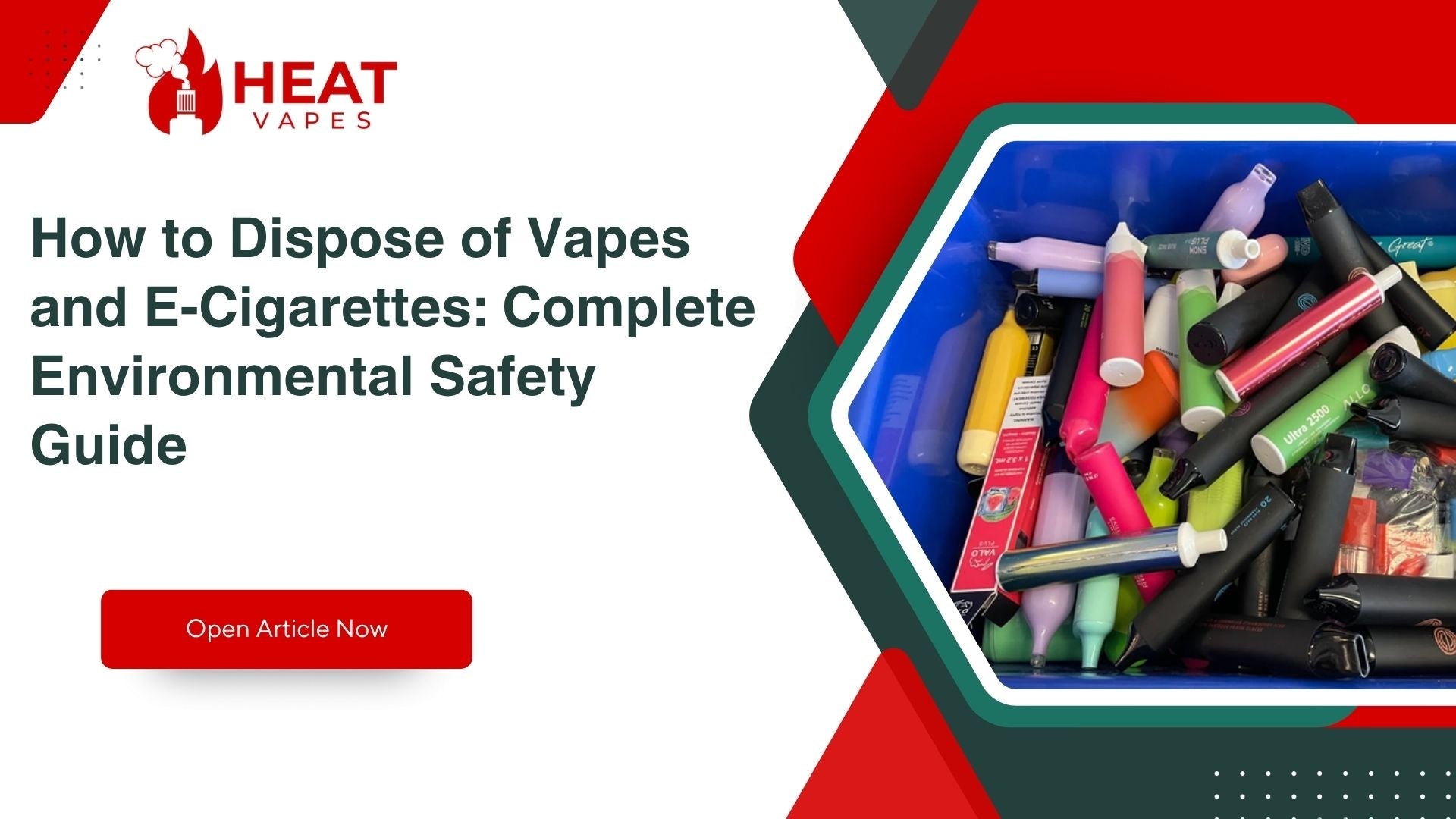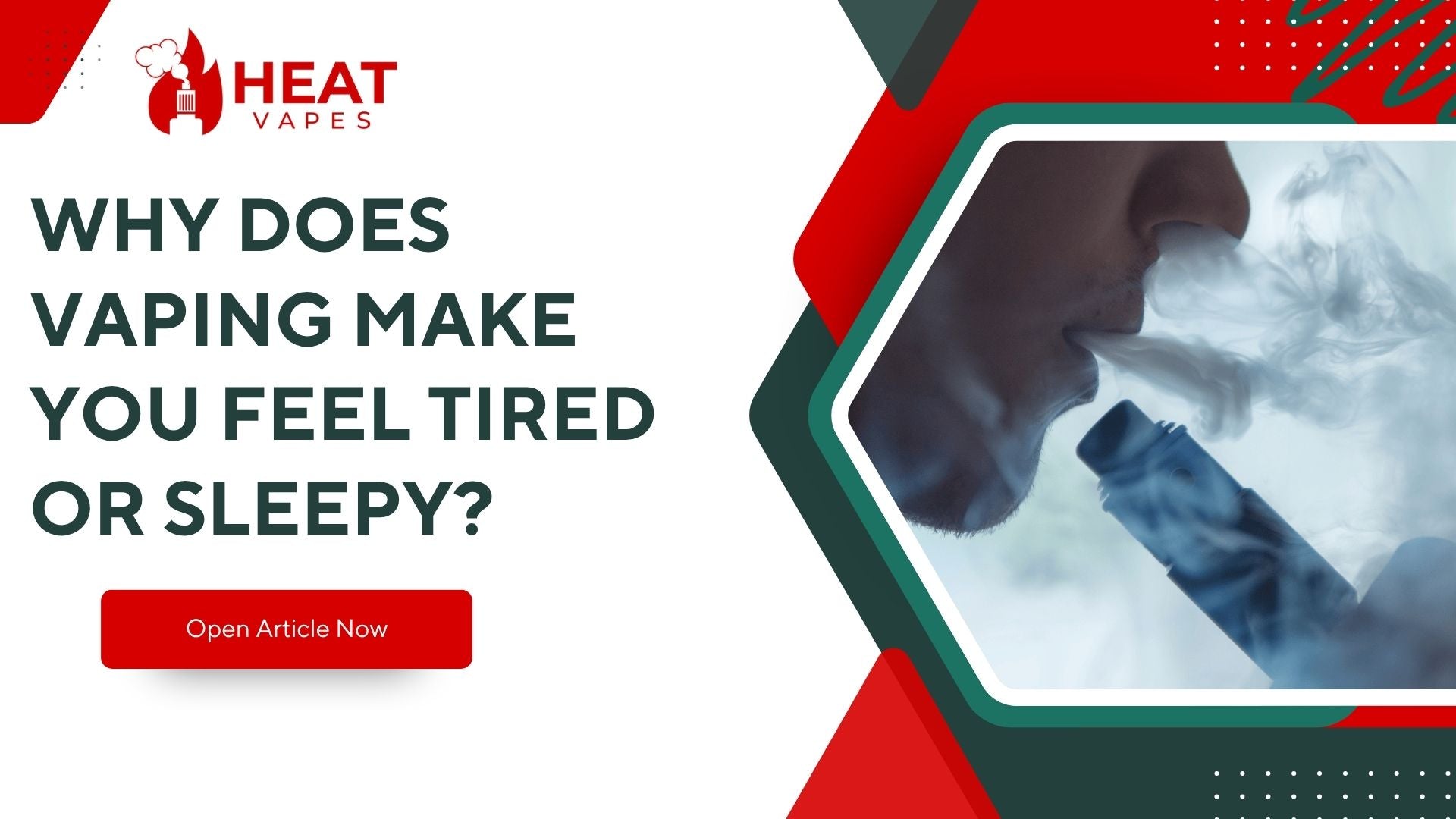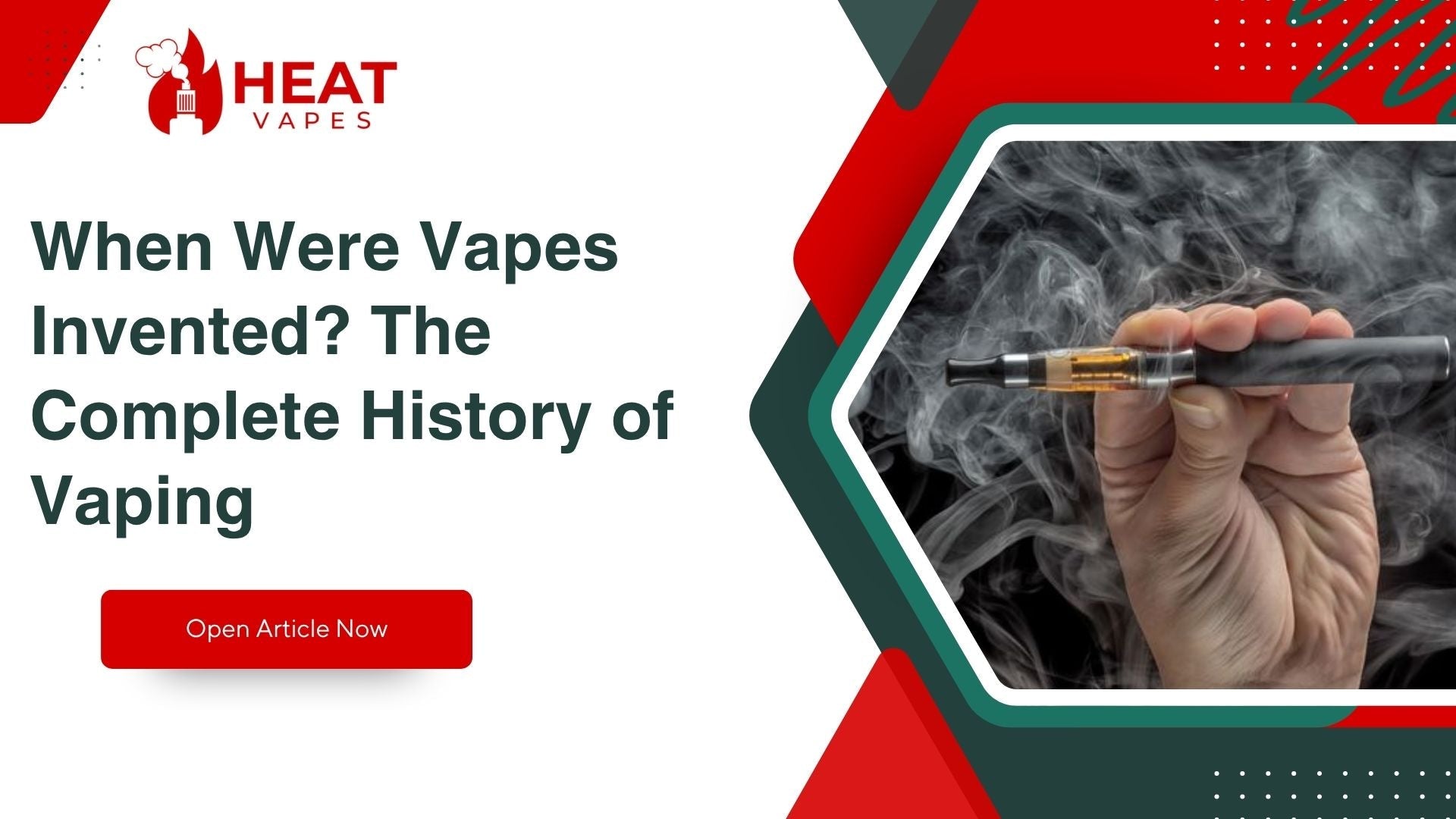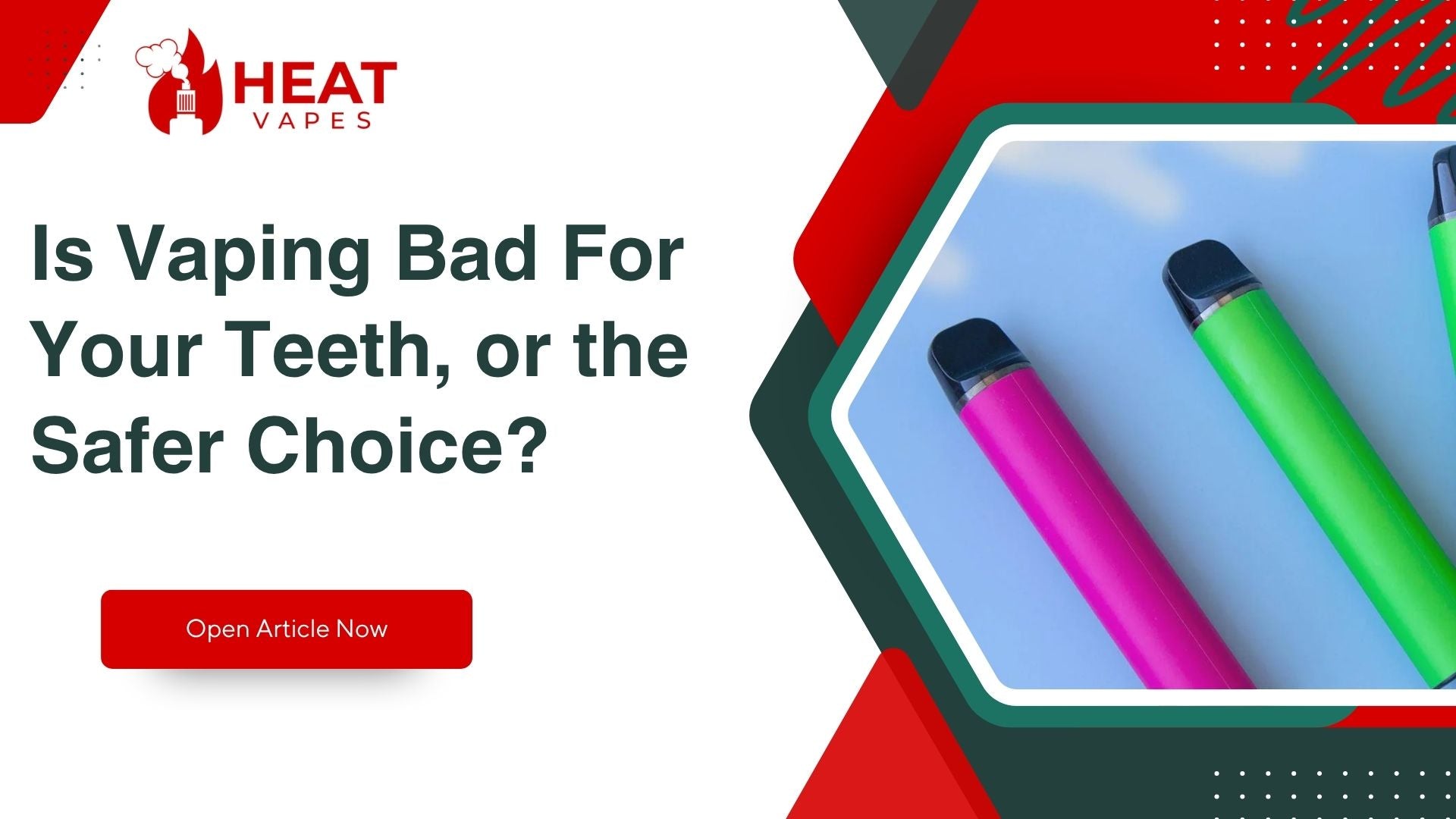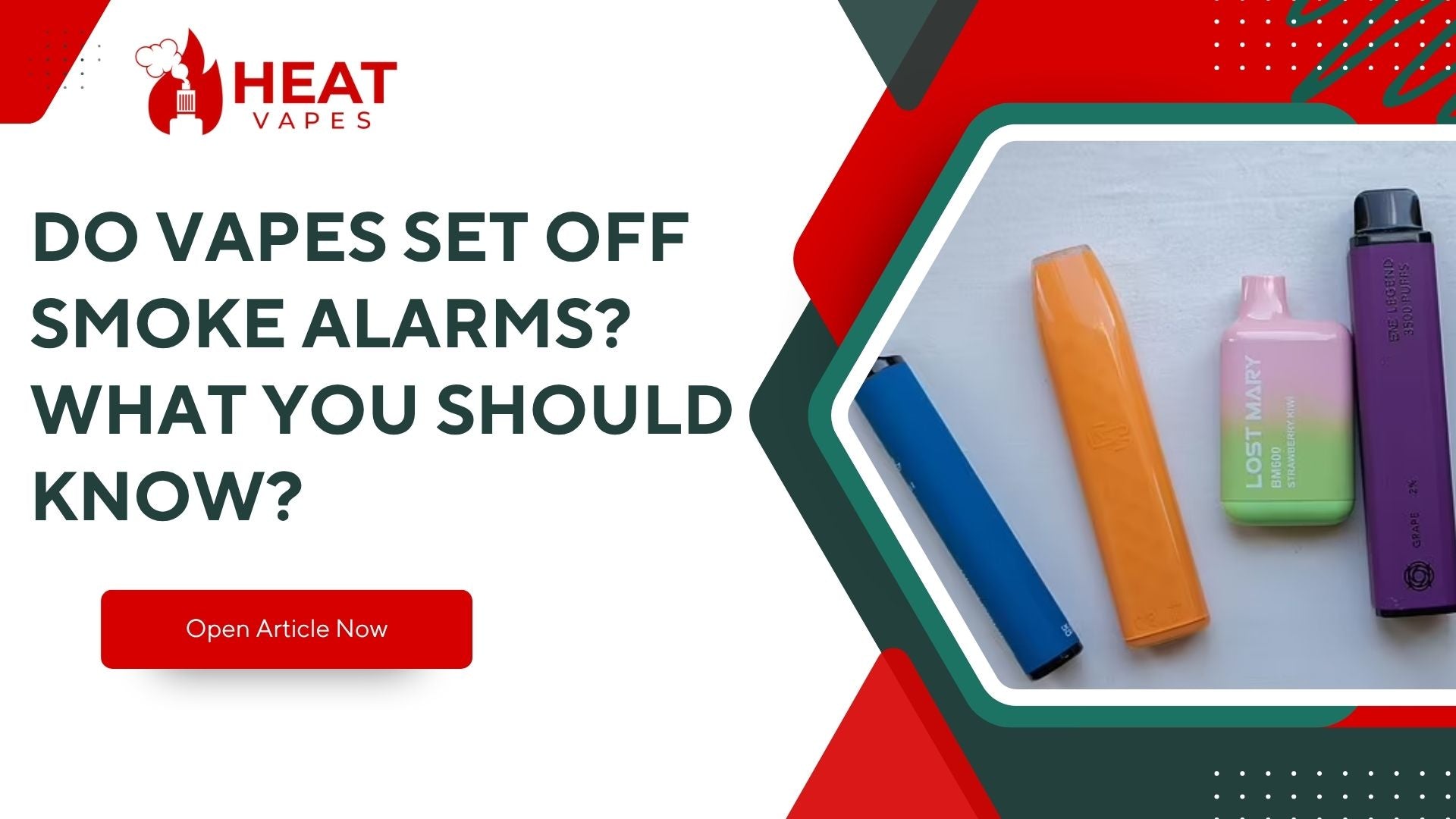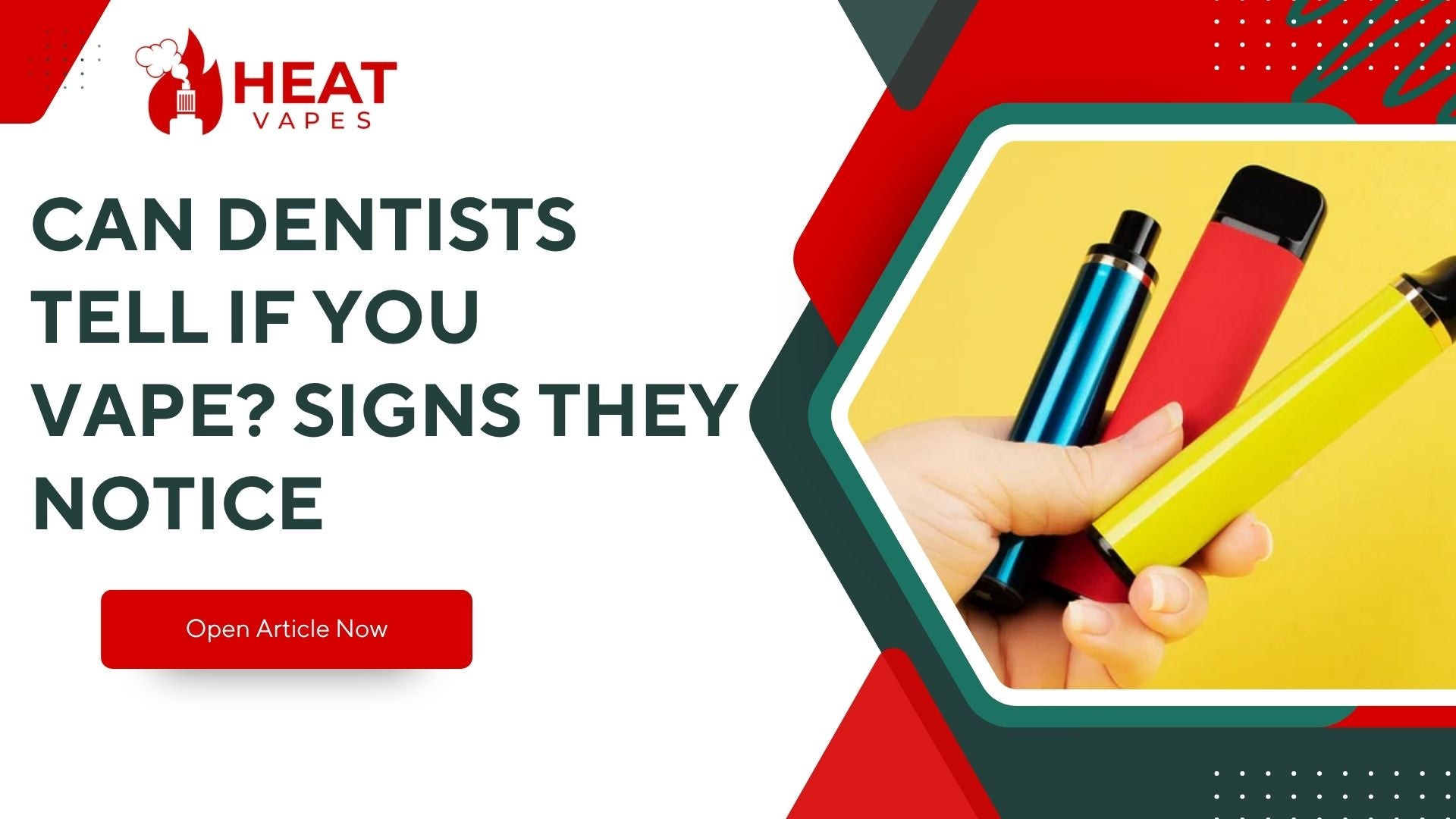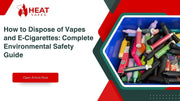
The improper disposal of vapes and e-cigarettes has emerged as a significant environmental concern in recent years. As the popularity of vaping devices continues to surge globally, we must address the critical issue of safe and responsible disposal methods. These electronic devices contain hazardous materials including lithium-ion batteries, toxic chemicals, and electronic components that pose serious risks to our environment and public health when discarded incorrectly.
How to Dispose of Vapes?
Before we delve into proper disposal methods, we need to comprehend what makes these devices environmentally hazardous. Modern vaping devices consist of multiple complex components that require specialized handling. The lithium-ion batteries within these devices represent one of the most dangerous elements, as they can explode or catch fire when damaged or exposed to extreme conditions in landfills.
The e-liquid cartridges contain nicotine, propylene glycol, vegetable glycerin, and various flavoring chemicals. Nicotine is classified as a hazardous waste substance and can contaminate soil and water sources when improperly disposed. The plastic housings, metal heating coils, and electronic circuitry further complicate the disposal process, making vapes a form of electronic waste (e-waste) that demands special attention.
The atomizers and heating elements typically contain metals such as copper, nickel, and chromium. These heavy metals can leach into groundwater systems when buried in landfills, creating long-term environmental contamination. The cotton wicking materials absorb residual e-liquid, which means even seemingly empty cartridges contain hazardous substances that require proper handling.
Why Proper Vape Disposal Matters for Environmental Safety
The environmental impact of improperly disposed vaping devices extends far beyond simple litter concerns. When we throw vapes into regular trash bins, they end up in landfills where their toxic components gradually decompose and release harmful substances. This contamination affects multiple ecological systems simultaneously and creates lasting damage that can persist for decades.
Lithium-ion batteries pose immediate fire hazards in waste management facilities. These batteries can short-circuit when compressed with other waste, leading to dangerous fires that threaten workers and release toxic fumes into the atmosphere. Waste management facilities across numerous countries have reported increasing incidents of fires caused by improperly disposed batteries from vaping devices.
The nicotine residue in discarded vapes presents particular dangers to wildlife and marine ecosystems. Studies have demonstrated that even minimal nicotine exposure can be lethal to aquatic organisms, birds, and small mammals. When rain water percolates through landfills containing discarded vapes, it creates a toxic leachate that carries these substances into natural water bodies.
Beyond immediate environmental concerns, improper disposal contributes to the growing global e-waste crisis. Electronic waste already represents one of the fastest-growing waste streams worldwide, and vaping devices accelerate this problem. The precious metals and rare earth elements in these devices are lost when not recovered through proper recycling channels.
Step-by-Step Guide to Disposing of Disposable Vapes
Disposable vapes present unique challenges because their integrated design makes component separation difficult. However, we must still ensure these devices reach appropriate recycling facilities rather than ending up in standard waste streams. The first step involves checking whether your disposable vape has any remaining e-liquid, as devices with liquid residue require additional precautions.
Never puncture or attempt to disassemble disposable vapes yourself, as this can cause battery fires or expose you to concentrated nicotine. Instead, place used disposable vapes in a clear plastic bag to prevent accidental activation during transportation. Keep these devices away from metal objects that could cause short-circuits, and never mix them with regular household waste or recyclables.
Contact your local waste management authority to identify designated e-waste collection points in your area. Many communities now offer specific drop-off locations for small electronics and batteries. Some retail stores that sell vaping products have also established take-back programs where consumers can return used disposables for proper recycling.
If immediate disposal is not possible, store used disposable vapes in a cool, dry location away from direct sunlight and heat sources. Keep them in a non-metallic container and ensure they are inaccessible to children and pets. Never store large quantities of used vapes together, as this increases fire risk should one device malfunction.
How to Safely Dispose of Rechargeable Vape Devices
Rechargeable vaping devices require a more detailed disassembly process before disposal. We recommend starting by removing the battery from the device if the design permits. Most rechargeable vapes feature removable battery compartments that allow for easier separation of components, though some integrated designs require professional handling.
Once the battery is removed, place it in a designated battery recycling container. Never throw loose batteries in regular trash or recycling bins, as they pose significant fire hazards. Most hardware stores, electronics retailers, and municipal recycling centers accept lithium-ion batteries through specialized collection programs. Some locations provide dedicated battery disposal boxes specifically designed to prevent short-circuits.
The remaining device body should be treated as electronic waste. Empty any residual e-liquid into an absorbent material like paper towels or coffee grounds, then seal this material in a plastic bag before disposal in regular trash. The empty tank and mouthpiece can typically be rinsed with water, though you should check local regulations regarding wastewater disposal of nicotine-containing liquids.
Metal components such as atomizer coils should be separated when possible and taken to metal recycling facilities. These heating elements contain valuable metals that can be recovered and reused in new products. The plastic housings and non-metal parts generally need to go to e-waste recycling centers that can properly process mixed materials.
Proper Disposal Methods for E-Liquid Cartridges and Pods
E-liquid cartridges and refillable pods require careful handling due to their nicotine content. Even cartridges that appear empty typically retain small amounts of liquid that classify them as hazardous waste. We must treat these components with the same caution as other nicotine-containing products to prevent environmental contamination.
Before disposing of cartridges, attempt to use all remaining e-liquid to minimize waste. If cartridges are damaged or no longer functional, remove them from the device and place them in a sealed plastic bag. Never rinse cartridges down drains, as nicotine can contaminate water treatment systems and harm aquatic life even in small concentrations.
Many manufacturers now offer mail-back programs for used cartridges and pods. These programs provide prepaid shipping labels that allow consumers to send used components back to the manufacturer for proper recycling. This closed-loop system ensures that materials are recovered efficiently and reduces the environmental burden on local waste management systems.
Some vape shops and retailers accept used cartridges for recycling as part of their corporate responsibility initiatives. These establishments partner with specialized recycling companies that can extract and properly dispose of residual e-liquids while recovering plastic and metal components. Supporting these programs helps create sustainable disposal infrastructure within the vaping industry.
Finding E-Waste Recycling Centers and Drop-Off Locations
Locating appropriate disposal facilities represents a crucial step in responsible vape recycling. We recommend starting your search with municipal waste management websites, which typically maintain directories of local e-waste collection sites. Many communities organize periodic hazardous waste collection events where residents can drop off various dangerous materials including vaping devices.
National retail chains increasingly offer in-store recycling programs for small electronics and batteries. Major electronics retailers often maintain collection bins near their entrances where customers can deposit old devices. These programs usually accept vaping devices along with other small electronics, though you should contact stores beforehand to confirm their specific policies.
Online resources such as Earth911 and Call2Recycle provide searchable databases of recycling locations based on zip code or address. These platforms allow you to filter results by material type, ensuring you find facilities equipped to handle lithium-ion batteries and electronic waste. Some databases also provide information about accepted quantities and any associated fees for disposal services.
Environmental organizations and advocacy groups frequently organize collection drives specifically targeting vaping waste. These events often coincide with environmental awareness campaigns and provide convenient opportunities for consumers to dispose of accumulated devices. Follow local environmental groups on social media or subscribe to their newsletters to stay informed about upcoming collection opportunities.
Retailer Take-Back Programs and Manufacturer Initiatives
Progressive vaping companies have recognized their responsibility in addressing disposal challenges and have implemented comprehensive take-back programs. These manufacturer-sponsored initiatives provide consumers with convenient options for returning used devices directly to the companies that produced them. Participating in these programs supports circular economy principles and reduces environmental impact.
Major vaping brands offer prepaid shipping labels through their websites, allowing customers to mail back used devices at no cost. Upon receiving returned products, manufacturers disassemble them in controlled environments and separate components for appropriate recycling or disposal. This process ensures that hazardous materials are handled by trained professionals with proper safety equipment.
Some companies have established partnerships with retail locations to serve as collection points for their products. Consumers can return used devices to participating stores regardless of where they originally purchased them. Store employees collect these devices and forward them to centralized recycling facilities through established logistics networks.
Retail chains specializing in vaping products increasingly implement in-house recycling programs as part of their corporate sustainability strategies. These programs often include educational materials that inform customers about proper disposal methods and the environmental importance of responsible recycling. Some retailers offer incentives such as discounts on future purchases for customers who return used devices.
Battery Safety and Specialized Battery Disposal
The lithium-ion batteries in vaping devices demand particular attention due to their volatile nature and environmental hazards. These rechargeable batteries contain corrosive electrolytes and can release toxic gases when damaged. We must handle them with extreme care throughout the disposal process to prevent accidents and environmental contamination.
Battery recycling programs specifically designed for lithium-ion cells exist in most developed countries. Organizations like Call2Recycle operate extensive networks of drop-off locations where consumers can safely dispose of rechargeable batteries. These programs ensure that batteries are transported to specialized facilities equipped with the technology and safety measures necessary for proper processing.
Never attempt to remove built-in batteries from integrated vaping devices unless you have proper training and equipment. Improper battery removal can cause short-circuits, fires, or chemical exposure. Devices with non-removable batteries should be taken to professional e-waste recyclers who possess the tools and expertise to safely extract batteries in controlled environments.
When storing batteries for disposal, keep them in non-conductive containers and tape over the terminals with non-metallic tape to prevent short-circuits. Store different battery types separately and never mix old batteries with new ones. Keep battery collection containers in cool, dry locations away from flammable materials and direct sunlight.
Understanding Local Regulations and Legal Requirements
Vaping device disposal regulations vary significantly across jurisdictions, making it essential to understand the specific requirements in your area. Some regions classify used vapes as universal waste, which requires special handling procedures and documentation. Other jurisdictions incorporate them into broader e-waste regulations that mandate manufacturer-funded recycling programs.
In the European Union, the Waste Electrical and Electronic Equipment (WEEE) Directive specifically covers vaping devices, requiring manufacturers to establish collection and recycling systems. These regulations mandate that producers bear financial responsibility for the end-of-life management of their products. Similar legislation exists in various forms across multiple countries worldwide.
United States regulations vary by state and municipality, with some areas implementing strict disposal requirements while others lack specific vaping waste legislation. States like California include vaping devices under their e-waste laws, prohibiting their disposal in regular trash. We encourage residents to research their local environmental protection agency websites for specific guidance.
Commercial establishments that generate vaping waste face additional regulatory requirements. Vape shops, retailers, and hospitality venues must often maintain documented waste management programs and contract with licensed hazardous waste haulers. These businesses should consult with environmental compliance specialists to ensure they meet all applicable regulations.
Environmental Impact of Improper Vape Disposal
The consequences of irresponsible vape disposal extend throughout multiple environmental systems. Soil contamination occurs when toxic components leach from landfills, affecting agricultural productivity and potentially entering food chains. Heavy metals from vaping devices can persist in soil for generations, creating lasting ecological damage that requires extensive remediation efforts.
Water pollution represents another critical concern. When toxic substances from discarded vapes enter waterways, they affect aquatic ecosystems at multiple trophic levels. Nicotine contamination has been documented in streams and rivers near landfills, with concentrations sufficient to harm fish populations and other aquatic organisms. This pollution can also impact drinking water sources in communities downstream from contaminated sites.
Air quality suffers when vaping devices contribute to landfill fires or are incinerated without proper controls. The combustion of plastic housings releases dioxins and other carcinogenic compounds into the atmosphere. Battery fires produce toxic fumes containing heavy metals and corrosive chemicals that pose immediate health risks to nearby populations.
The accumulation of vaping waste in natural environments creates visual pollution and physical hazards. Discarded devices contaminate beaches, parks, and wilderness areas, harming wildlife through both direct ingestion and habitat degradation. Marine animals frequently mistake vaping components for food, leading to internal injuries and toxic exposure that can prove fatal.
Creating a Sustainable Vaping Practice
Responsible vaping extends beyond proper disposal to encompass conscious purchasing decisions and usage patterns. We recommend choosing rechargeable devices over disposables whenever possible, as reusable devices generate significantly less waste over their lifetime. Although rechargeable systems require higher initial investment, their environmental footprint and long-term cost prove substantially lower.
Selecting devices from manufacturers with established recycling programs demonstrates environmental stewardship and supports companies prioritizing sustainability. Research brands before purchasing to identify those offering take-back initiatives, using recycled materials in their products, or contributing to environmental conservation programs. Consumer demand for sustainable options drives industry-wide improvements.
Maintaining devices properly extends their lifespan and reduces replacement frequency. Regular cleaning, careful handling, and following manufacturer guidelines for charging and storage prevent premature failures. Well-maintained devices deliver better performance while generating less waste, making proper care both economically and environmentally beneficial.
Consider joining or forming community initiatives focused on vaping waste reduction. Organizing local collection drives, sharing information about disposal options, and advocating for improved recycling infrastructure creates positive change at the grassroots level. Collective action amplifies individual efforts and demonstrates to policymakers and manufacturers that consumers prioritize environmental responsibility.
Education and Awareness About Vaping Waste
Widespread education about proper vape disposal remains insufficient despite the growing prevalence of these devices. Many users simply lack awareness that vapes require specialized disposal rather than regular trash disposal. We must prioritize comprehensive public education campaigns that reach diverse demographics and effectively communicate the environmental importance of responsible recycling.
Healthcare providers, educators, and community leaders should incorporate vaping waste information into existing substance education programs. Discussing proper disposal alongside health effects creates a more complete understanding of vaping's impacts. Schools and youth organizations should address these topics proactively, as younger demographics represent significant portions of vaping populations.
Social media campaigns can effectively spread awareness about vaping waste issues and disposal solutions. Creating shareable content that explains proper disposal methods in accessible formats reaches broad audiences quickly. Influencers and advocates within vaping communities can leverage their platforms to normalize responsible disposal practices and challenge the perception that environmental concerns are secondary.
Point-of-sale education represents another crucial opportunity. Retailers should provide disposal information at the time of purchase, ensuring customers understand their responsibilities before using products. Including disposal instructions on packaging and prominently displaying information about take-back programs reinforces these messages and makes proper disposal more convenient.
Innovations in Vape Recycling Technology
The vaping industry and recycling sector are developing innovative solutions to address disposal challenges. New separation technologies enable more efficient recovery of materials from complex vaping devices. Automated disassembly systems can quickly separate batteries, metals, and plastics, making recycling operations more economically viable and environmentally effective.
Some companies are exploring biodegradable materials for vaping device components. While technical challenges remain regarding performance and safety, biodegradable plastics and plant-based materials could significantly reduce the environmental persistence of discarded devices. Research continues into materials that maintain necessary functionality while breaking down more rapidly in natural environments.
Chemical recycling processes show promise for handling contaminated plastics from vaping devices. These technologies break down plastics at the molecular level, enabling purification and reformation into new materials. Advanced recycling methods can process materials too contaminated for mechanical recycling, potentially recovering value from components currently destined for landfills.
Battery recycling technology continues advancing, with new processes recovering higher percentages of valuable materials. Direct recycling methods that preserve battery structure and chemistry could make lithium-ion battery recycling more efficient and less energy-intensive. These technological improvements enhance the economic viability of battery recycling and reduce reliance on virgin materials for new battery production.





